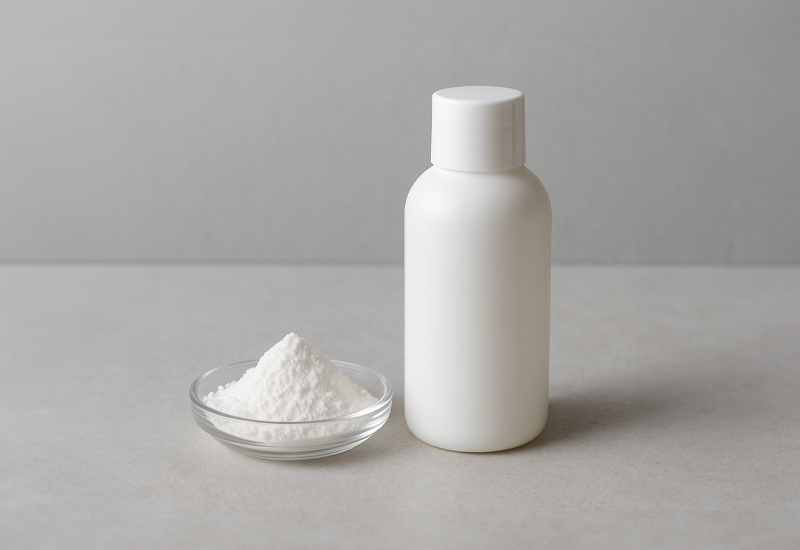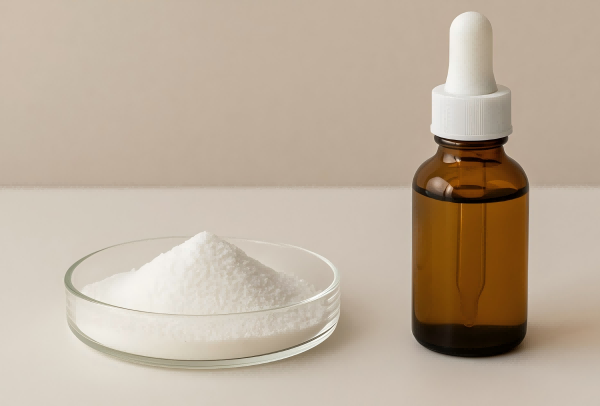The components in skincare products have become more widely known to customers in recent years. Among the emerging components gaining interest is Etidronic Acid—a chemical often recognized in industrial applications but now gaining relevance in personal care and cosmetics. As a chelating and stabilizing agent, Etidronic Acid may not be a “glamorous” skincare ingredient like vitamin C or retinol, but its role is both essential and increasingly appreciated.
What Is Etidronic Acid?
Chemical Overview
- INCI Name: Etidronic Acid
- Other Names: 1-Hydroxyethylidene-1,1-diphosphonic acid (HEDP), Hydroxyethane Diphosphonic Acid
- Molecular Formula: C₂H₈O₇P₂
- Molar Mass: 206.03 g/mol
- Chemical Structure: Organophosphonate containing two phosphonic acid groups and one hydroxyethylidene group
- Solubility: Highly water-soluble
Functional Role
Etidronic acid is primarily used in cosmetics and personal care as:
- A chelating agent: Iron, copper, and calcium are among the metal ions that it binds to stop them from deteriorating the formula or irritating the skin.
- A stabilizer: It helps prevent rancidity and degradation of cosmetic formulations by reducing oxidation caused by metal contamination.
- A pH adjuster and buffering agent: Due to its acid nature, it can slightly adjust or stabilize the pH of the product.
Is Etidronic Acid Natural?
No. Etidronic acid is synthetically produced, although it is biochemically inspired. It belongs to a class of organophosphonates and mimics compounds found in bones and teeth. It is not derived from plants or animals, which means it’s vegan and cruelty-free, often used in formulations that meet clean beauty standards.
Mechanism of Action on the Skin
Etidronic acid does not act directly on skin cells like actives such as AHAs, BHAs, or peptides. Instead, its role is more supportive, functioning behind the scenes:
Chelation of Metal Ions
Water, pigments, and even skin-contacting metals (e.g., from razors or jewelry) can release trace metal ions. These ions:
- Promote free radical generation
- Catalyze oxidation of ingredients like vitamin C or essential oils
- Lead to skin sensitivity or breakouts
Etidronic acid neutralizes these ions, thereby:
- Preserving product stability
- Minimizing skin irritation
- Enhancing the shelf life of active ingredients
Synergistic Role with Antioxidants
When used with antioxidants like tocopherol (vitamin E) or ascorbic acid (vitamin C), Etidronic Acid helps prevent premature oxidation, allowing these actives to remain effective longer.

Benefits of Etidronic Acid in Skincare
| Benefit | Explanation |
| Gentle on skin | Does not penetrate deeply or irritate the skin barrier |
| Improves formulation stability | Prevents breakdown of emulsions, serums, and creams |
| Boosts preservative performance | Reduces metal-catalyzed microbial growth |
| Protects active ingredients | Helps maintain potency of vitamin C, niacinamide, retinoids |
| Reduces skin irritation | By preventing metal-triggered oxidative stress |
| pH control | Offers mild acidification without sensitization |
Although it does not exfoliate or hydrate, its presence improves overall product performance, making your actives work better and last longer.
Common Product Types Containing Etidronic Acid
Etidronic Acid can be found in a wide variety of skincare and personal care products, especially in formulations targeting sensitive or acne-prone skin.
Cleansers
- Prevents soap scum formation
- Stabilizes surfactants and maintains clarity
Moisturizers
- Prevents rancidity from natural oils (jojoba, rosehip, etc.)
- Supports antioxidant systems
Serums
- Particularly common in vitamin C and peptide-based serums
- Helps retain clarity and effectiveness
Sunscreens
- Prevents interaction between metal oxides (e.g., titanium dioxide) and other ingredients
- Maintains product texture and color
Haircare Products
- Found in shampoos and conditioners to prevent buildup and preserve scent
- Reduces mineral scale from hard water
Safety and Toxicity
Regulatory Approval
- Cosmetic Ingredient Review (CIR)-approved
- Listed in EU Cosmetic Regulation Annex
- Approved by Health Canada, FDA, and Japan MHLW
Safe Concentration Range
- Typically used at 0.01% to 0.2% concentration in cosmetic products
- Not absorbed through the skin
- Not classified as a skin sensitizer or carcinogen
Toxicity Profile
| Category | Assessment |
| Skin Irritation | Non-irritating (low risk) |
| Eye Irritation | Mild at higher concentrations (>1%) |
| Reproductive Toxicity | No evidence |
| Carcinogenicity | Not classified |
Etidronic acid has been studied in both oral and topical models and is considered safe for use in rinse-off and leave-on products.
Differences Between Etidronic Acid and Other Chelators
| Chelating Agent | Stability | Skin Tolerance | Environmental Impact |
| EDTA | High | Mild | Poor biodegradability |
| Sodium Gluconate | Moderate | Excellent | Biodegradable |
| Phytic Acid | Low pH only | Moderate | Eco-friendly |
| Etidronic Acid | High | Excellent | Moderately biodegradable |
Etidronic acid offers a better environmental profile than EDTA, though not as natural as phytic or gluconic acid. It’s a good balance for those seeking effective but mild formulations.
Who Should Use Etidronic Acid in Skincare Products?
✅ Good for:
- Skin types that are sensitive and easily irritated
- Acne-prone individuals (helps reduce pore congestion due to metal ions)
- People using high-antioxidant or anti-aging products
- Those living in areas with hard water
❌ Not necessary for:
- Individuals using purely oil-based skincare (no water = less need for chelators)
- Those who prefer 100% natural or minimalist skincare
- Skin with active barrier damage (check full formula first)
Etidronic Acid vs. Phytic Acid
Many users confuse Etidronic Acid with Phytic Acid, another chelating agent in cosmetics. Here’s a quick breakdown:
| Parameter | Etidronic Acid | Phytic Acid |
| Source | Synthetic | Plant-derived (grains) |
| Chelating Strength | Strong (broad spectrum) | Mild (Fe, Cu only) |
| pH Range | Broad (2–10) | Narrow (best under 6) |
| Environmental Impact | Moderate | Biodegradable |
| Cost | Low | High |
Real-World Product Examples
- Vitamin C Serums – Helps prevent oxidation and darkening over time.
- Daily Moisturizers with Antioxidants – Keeps formula stable throughout usage period.
- Whitening Creams – Chelates iron/copper ions that can darken formulas.
- Hair Care Products – Prevents calcium/magnesium scaling that leads to dullness and buildup.
Always check the ingredient list for “Etidronic Acid” or “HEDP” (sometimes in sodium salt form).
Environmental Considerations
Etidronic acid is moderately biodegradable, particularly under oxidative and photolytic conditions. While it does not bioaccumulate or pose high aquatic toxicity at cosmetic levels, its widespread industrial use (e.g., in detergents and water treatment) does raise some concern.
Best Practices for Use:
- Use products with lower concentrations (<0.1%)
- Do not dispose of concentrated solutions into waterways
- Support brands with proper wastewater treatment policies
While it may not be the star ingredient in your skincare routine, Etidronic Acid plays a crucial backstage role in stabilizing, preserving, and enhancing the performance of actives. For formulators, it’s a workhorse. For consumers, it’s a quiet protector—minimizing irritation, improving shelf life, and making your favorite products more effective.
From a chemical supplier’s perspective, Etidronic Acid is one of the most reliable and versatile agents for modern skincare applications. It is a great option for a variety of products due to its pH adaptability, safety, compatibility, and chemical robustness.

